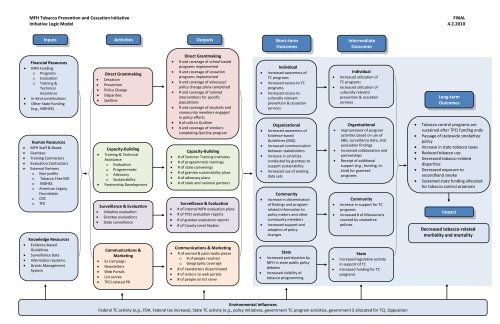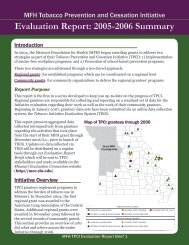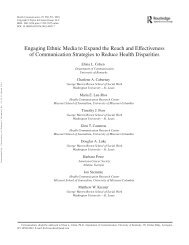Logic Model
Logic Model
Logic Model
You also want an ePaper? Increase the reach of your titles
YUMPU automatically turns print PDFs into web optimized ePapers that Google loves.
MFH Tobacco Prevention and Cessation Initiative<br />
FINAL<br />
Initiative <strong>Logic</strong> <strong>Model</strong> 4.2.2010<br />
Inputs Activities Outputs Short-term<br />
Outcomes<br />
Intermediate<br />
Outcomes<br />
Financial Resources<br />
• MFH Funding<br />
o Programs<br />
o Evaluation<br />
o Training &<br />
Technical<br />
Assistance<br />
• In-kind contributions<br />
• Other State Funding<br />
(e.g., MDHSS)<br />
Human Resources<br />
• MFH Staff & Board<br />
• Grantees<br />
• Training Contractors<br />
• Evaluation Contractors<br />
• External Partners<br />
o Non-profits<br />
o Tobacco Free MO<br />
o MDHSS<br />
o American Legacy<br />
Foundation<br />
o CDC<br />
o TFK<br />
Knowledge Resources<br />
• Evidence-based<br />
Guidelines<br />
• Surveillance Data<br />
• Information Systems<br />
• Grants Management<br />
System<br />
Direct Grantmaking<br />
• Cessation<br />
• Prevention<br />
• Policy Change<br />
• Disparities<br />
• Quitline<br />
Capacity-Building<br />
• Training & Technical<br />
Assistance<br />
o Evaluation<br />
o Programmatic<br />
o Advocacy<br />
o Sustainability<br />
• Partnership Development<br />
Surveillance & Evaluation<br />
• Initiative evaluation<br />
• Grantee evaluations<br />
• State surveillance<br />
Communications &<br />
Marketing<br />
• Ex Campaign<br />
• Newsletters<br />
• Web Portals<br />
• List serves<br />
• TPCI-related PR<br />
Direct Grantmaking<br />
• # and coverage of school-based<br />
programs implemented<br />
• # and coverage of cessation<br />
programs implemented<br />
• # and coverage of advocacy/<br />
policy change plans completed<br />
• # and coverage of tailored<br />
interventions for specific<br />
populations<br />
• # and coverage of students and<br />
community members engaged<br />
in policy efforts<br />
• # of calls to Quitline<br />
• # and coverage of smokers<br />
completing Quitline program<br />
Capacity-Building<br />
• # of Summer Training Institutes<br />
• # of programmatic trainings<br />
• # of state convenings<br />
• # of grantee sustainability plans<br />
• # of advocacy plans<br />
• # of state and national partners<br />
Surveillance & Evaluation<br />
• # of internal MFH evaluation plans<br />
• # of TPCI evaluation reports<br />
• # of grantee evaluation reports<br />
• # of County Level Studies<br />
Communications & Marketing<br />
• # of earned & paid media pieces<br />
o # of people reached<br />
o Geographic coverage<br />
• # of newsletters disseminated<br />
• # of visitors to web portals<br />
• # of people on list serve<br />
Individual<br />
• Increased awareness of<br />
TC programs<br />
• Increased access to TC<br />
programs<br />
• Increased access to<br />
culturally relevant<br />
prevention & cessation<br />
services<br />
Organizational<br />
• Increased awareness of<br />
Evidence-based<br />
Guidelines (EBG)<br />
• Increased communication<br />
between stakeholders<br />
• Increase in activities<br />
conducted by grantees to<br />
support sustainability<br />
• Increased use of existing<br />
data sets<br />
Community<br />
• Increase in dissemination<br />
of findings and programrelated<br />
information to<br />
policy makers and other<br />
community members<br />
• Increased support and<br />
adoption of policy<br />
changes<br />
State<br />
• Increased participation by<br />
MFH in state public policy<br />
debates<br />
• Increased visibility of<br />
tobacco programming<br />
Individual<br />
• Increased utilization of<br />
TC programs<br />
• Increased utilization of<br />
culturally relevant<br />
prevention & cessation<br />
services<br />
Organizational<br />
• Improvement of program<br />
activities based on use of<br />
EBG, surveillance data, and<br />
evaluation findings<br />
• Increased collaboration and<br />
partnerships<br />
• Receipt of additional<br />
support (e.g., funding, inkind)<br />
for grantees’<br />
programs<br />
Community<br />
• Increase in support for TC<br />
programs<br />
• Increased # of Missourians<br />
covered by smokefree<br />
policies<br />
State<br />
• Increased legislative activity<br />
in support of TC<br />
• Increased funding for TC<br />
programs<br />
Long-term<br />
Outcomes<br />
• Tobacco control programs are<br />
sustained after TPCI funding ends<br />
• Passage of statewide smokefree<br />
policy<br />
• Increase in state tobacco taxes<br />
• Reduced tobacco use<br />
• Decreased tobacco-related<br />
disparities<br />
• Decreased exposure to<br />
secondhand smoke<br />
• Sustained state funding allocated<br />
for tobacco control programs<br />
Impact<br />
Decreased tobacco-related<br />
morbidity and mortality<br />
Environmental Influences<br />
Federal TC activity (e.g., FDA, Federal tax increase), State TC activity (e.g., policy initiatives, government TC program activities, government $ allocated for TC), Opposition
MFH Tobacco Prevention and Cessation Initiative<br />
Final<br />
Community Grants Strategy <strong>Logic</strong> <strong>Model</strong> 4.8.2010<br />
Inputs<br />
Activities Outputs Outcomes<br />
Financial Resources<br />
• MFH funding<br />
• Other funding (e.g., MDHSS)<br />
• In-kind contributions<br />
Capacity-Building<br />
• Additional funding provided<br />
• Materials/resources shared<br />
• Training offered<br />
• Technical assistance utilized<br />
• Program marketing<br />
• Program product and/or<br />
results dissemination<br />
Capacity-Building<br />
• Amount of funding provided<br />
• # and types of:<br />
o Materials/resources shared<br />
o Trainings offered<br />
o Technical assistance utilized<br />
• Types and reach of:<br />
o<br />
o<br />
Program marketing<br />
Product and/or results<br />
dissemination<br />
Short‐term<br />
• Increased awareness of TC prevention &<br />
cessation programs<br />
• Increased access to TC prevention &<br />
cessation programs<br />
• Increased awareness and salience of<br />
tobacco issue<br />
• Increased support for tobacco-related<br />
programs and policy changes<br />
• Increased participation by MFH grantees<br />
in state public policy debates<br />
Human Resources<br />
• MFH Staff<br />
• Grantee leadership<br />
• Grantee staff<br />
• Training contractors<br />
• Evaluation contractors<br />
• External Partners<br />
o Universities<br />
o Schools<br />
o MDHSS<br />
o ANR<br />
o Local businesses<br />
Knowledge Resources<br />
• Evidence-based guidelines<br />
• Surveillance data<br />
• Existing TC programs<br />
• <strong>Model</strong> smoke-free policies<br />
Cessation<br />
• Cessation services offered<br />
• Existing cessation services<br />
promoted<br />
• Systems changed to encourage<br />
or support cessation<br />
• Tobacco-related education<br />
Policy Advocacy<br />
• Coalition & network building<br />
• Grassroots organizing &<br />
mobilization<br />
• Tobacco-related education<br />
• Policy-related education for:<br />
o General public<br />
o Business owners<br />
o Decision makers<br />
• Polling<br />
• Relationship building with<br />
decision makers<br />
• Policy proposal development<br />
Cessation<br />
• #, types and coverage of:<br />
o Cessation services offered<br />
o Cessation services promoted<br />
• # of individuals:<br />
o Beginning cessation program<br />
Completing cessation program<br />
o Referred to cessation services<br />
• # overall and # of settings where:<br />
o Plans for system change created<br />
o Systems changes occurred<br />
Policy Advocacy<br />
• # and level of involvement of<br />
coalition members<br />
• # of community events held and<br />
attendance<br />
• #, types and reach of methods used<br />
for policy-related education<br />
• # of meetings held with decision<br />
makers<br />
• # of policy proposals developed<br />
Intermediate<br />
• Increased utilization of TC prevention &<br />
cessation programs<br />
• Increased capacity to implement TC<br />
programs and policies among those<br />
involved in funded programs<br />
• Tobacco-related policy:<br />
o Developed<br />
o Placed on policy agenda<br />
o Enacted<br />
o Implemented properly<br />
o Monitored for compliance<br />
o Maintained<br />
Long-term<br />
• Reduced tobacco use<br />
• Decreased exposure to secondhand smoke<br />
• Decreased tobacco-related morbidity and<br />
mortality<br />
Environmental Influences<br />
Federal TC activity (e.g., FDA, Federal tax increase), State TC activity (e.g., policy initiatives, government TC program activities, government $ allocated for TC), Opposition
MFH Tobacco Prevention and Cessation Initiative<br />
Final<br />
Support for Tobacco Policy Change Strategy <strong>Logic</strong> <strong>Model</strong> 4.2.2010<br />
Inputs<br />
Activities<br />
Outputs<br />
Outcomes<br />
Financial Resources<br />
• MFH funding<br />
• Other funding (e.g., ACS,<br />
RWJF)<br />
• In-kind contributions<br />
Community Outreach<br />
• Coalition & network<br />
building<br />
• Grassroots organizing &<br />
mobilization<br />
• Polling<br />
• Business owner education<br />
• General public education<br />
• Rallies & marches<br />
Community Outreach<br />
• # of coalition members<br />
• # of constituency types represented in coalition<br />
• # of coalition meetings held & attendance<br />
• # of community events held & attendance<br />
• # and types of education materials developed<br />
• # and types of business owners reached<br />
• # of general public reached<br />
Short-term<br />
• Increased coalition capacity for advocacy<br />
• Policy agenda alignment within coalition<br />
• Increased number of advocates, including unlikely or<br />
nontraditional<br />
• Increased partnerships with organizations or<br />
individuals who support advocacy strategy<br />
• Increased number of champions for issue<br />
• Increased awareness and salience of tobacco issue<br />
• Increased public and political will to support policy<br />
• Increased participation by MFH grantees in state<br />
public policy debates<br />
Human Resources<br />
• MFH Staff<br />
• Grantees<br />
• Coalitions<br />
• Training contractors<br />
• Evaluation contractors<br />
• External Partners<br />
o Universities<br />
o MDHSS<br />
o ANR<br />
o Local businesses<br />
Communication<br />
• Presentations<br />
• Electronic outreach/social<br />
media<br />
• Earned media<br />
• Paid media<br />
• PSAs<br />
Communication<br />
• # of communications (e.g., briefings, presentations,<br />
emails, letters to the editor, advertisements, PSAs)<br />
• # of audience types reached through communications<br />
• # of individuals reached through communications<br />
Intermediate<br />
• Tobacco-related policy:<br />
o Developed<br />
o Placed on policy agenda<br />
o Enacted<br />
o Implemented properly<br />
o Monitored for compliance<br />
o Maintained<br />
Knowledge Resources<br />
• Evidence-based<br />
Guidelines<br />
• Surveillance data<br />
• <strong>Model</strong> policies<br />
Policy Advocacy<br />
• Policy proposal<br />
development<br />
• Policymaker education<br />
• Relationship building with<br />
decision makers<br />
Policy Advocacy<br />
• # of policy proposals developed<br />
• # of organizations signing on to policy proposals<br />
• # of educational contacts with policymakers<br />
• # of policymakers reached through education<br />
• # of meetings held with decision makers<br />
Long-term<br />
• Reduced tobacco use<br />
• Decreased exposure to secondhand smoke<br />
• Decreased tobacco-related morbidity and mortality<br />
Environmental Influences<br />
Political Environment (Federal, State and Local), Tobacco Control Opposition, State and Local TC Activity (e.g., other policy initiatives, TC program activities, $ allocated for TC), Capacity-building Activities
MFH Tobacco Prevention and Cessation Initiative<br />
Final<br />
Eliminating Tobacco-related Disparities Strategy <strong>Logic</strong> <strong>Model</strong> 4.2.2010<br />
Inputs<br />
Activities<br />
Outputs<br />
Outcomes<br />
Financial Resources<br />
• MFH funding<br />
• Other funding (e.g.,<br />
MDHSS)<br />
• In-kind contributions<br />
Assessment<br />
• Advisory group convening<br />
• Data collection & analysis<br />
• Report development<br />
• Report dissemination<br />
Assessment<br />
• # of partners engaged<br />
• # of surveys completed<br />
• # of focus groups completed<br />
• Final results reports<br />
• Media coverage<br />
Short‐term<br />
• Increased awareness of tobacco-related<br />
disparities among populations<br />
• Tobacco-related health issues a higher<br />
priority within priority populations<br />
• Increased awareness of prevention<br />
services among priority populations<br />
• Increased awareness of cessation<br />
services among priority populations<br />
• Priority populations a higher priority for<br />
grantees<br />
Human Resources<br />
• MFH Staff<br />
• Grantees<br />
• Advisory group<br />
• Training contractors<br />
• Evaluation contractors<br />
• External Partners<br />
o Universities<br />
o<br />
o<br />
MDHSS<br />
CDC National<br />
Networks<br />
Planning<br />
• Stakeholder convening<br />
• Intervention goals and<br />
objectives development<br />
• Identification of intervention<br />
approach and existing<br />
relevant programs<br />
• Intervention development/<br />
modification<br />
Planning<br />
• # of partners engaged in<br />
planning process<br />
• Planned interventions<br />
Intermediate<br />
• Increased use of prevention services by<br />
priority populations<br />
• Increased use of cessation services by<br />
priority populations<br />
• Increased grantee capacity around<br />
tobacco-related disparities<br />
• Stronger networks among priority<br />
populations<br />
Knowledge Resources<br />
• Evidence-based<br />
Guidelines<br />
• Surveillance data<br />
• Existing TC programs<br />
Implementation & Evaluation<br />
• Staff training to implement<br />
intervention<br />
• Site/participant recruitment<br />
• Intervention piloting<br />
• Process evaluation<br />
• Intervention revision,<br />
as needed<br />
Outcome evaluation<br />
• Product dissemination<br />
Implementation & Evaluation<br />
• # of staff trained to implement<br />
interventions<br />
• # and coverage of intervention<br />
participants<br />
• Final reports of interventions<br />
• # of methods used to<br />
disseminate products<br />
• # of products disseminated<br />
Long-term<br />
• Reduced tobacco use among priority<br />
populations<br />
• Decreased tobacco-related disparities<br />
• Decreased tobacco-related morbidity<br />
and mortality







